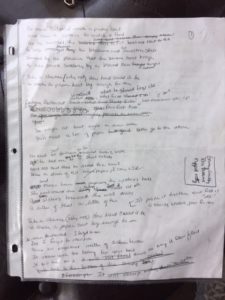The following are the words of Liz Cooper, Archway Publishing author of “Granny’s Teeth: A Collection of Quirky Rhyming Tales.” For more information on Liz or her book, find her on her website, Facebook or Twitter. Download the Archway Publishing free publishing guide for more information on our supported self-publishing services.
I recently met a college English major. He spent his summer working on a novel before giving up. When I asked him what his novel was about, he shrugged and said, “I don’t know, I started writing, and I waited for it to reveal itself.” He couldn’t even tell me the genre. Wow. He seemed to think that a great novel would just “happen.” No wonder he became discouraged. He didn’t take advantage of the Writing Process.
I’ve taught writing to elementary students up through college freshman. Convincing aspiring writers, to mindfully use the Writing Process can be challenging. Many writers like to “wing it.” I tell them that It’s better to follow these steps:
Brainstorming
The old adage, ‘write what you know’ is true. For my book, Granny’s Teeth – A Collection of Quirky Rhyming Tales, I knew I wanted to write funny stories about kids at play. I thought about my own childhood experiences at the beach and sleeping at my grandmother’s house where I loved watching her take her false teeth out at night. As I reminisced, my imagination kicked in. What if the ocean was alive and tried to steal a boy’s sand castle? What if Granny loaned her homesick grandchild her false teeth in a jar to keep her company? Even better, what if the teeth started talking and kept the child up all night?
Plan

Make a plan, even if it’s jotting down a short summary of the beginning, middle, and ending of the story on the back of a napkin. Some people like to type a formal outline or use a graphic organizer. Make an overall book plan before breaking it down further. When I wrote Francois and the Tide, the first story in my book, the basic plot was comprised of five simple sentences: Boy builds a sand castle, Ocean knocks sand castle over, Boy digs a hole, Ocean fills it up. Boy discouraged until he finds a seashell.
Rough Draft
The next step is to commit your story to paper as quickly as you can. Your draft doesn’t have to be neat. I like scribbling or typing as quickly as I can before I forget my great ideas. This is a picture of the very first draft of Bertram Butternut- Innovator, another tale in Granny’s Teeth. It’s a mess, but I knew I wanted Bertram to keep coming up with new ideas in a cause and effect formula until he finally grows an apple tree. As you can see, my brain was moving faster than my pen.
Revise, Revise, Revise
Revising is my favorite part of the writing process. I change words, add transitions, move things around, and attend to the details that make the writing come alive and ensure that the story makes perfect sense. For Francois, I substituted interesting words, i.e. fortress instead of a castle. I added personification; the ocean and the boy taunt each other over who is going to prevail. Lastly, I made several changes to make sure that my rhyming wasn’t forced. It must have worked because this story came in the top ten out of a field of 5,000 entries in a writing contest sponsored by a major publisher.
 Editing
Editing
The very last step is editing. I highly recommend that authors invest in professional editing. I taught a college grammar course, and I still make mistakes! Errors in usage, punctuation, and spelling distract the reader and blur the author’s message. I used Archway’s excellent editorial service and it was well worth it!
As simple as it sounds, it’s true. Using the Writing Process will provide the orderly steps for completing a successful, and enjoyable, writing project.
Archway Publishing is always looking for content for its blog. If you’re an Archway Publishing author and would like to share a guest blog post, please visit our Blog Guidelines Page.
